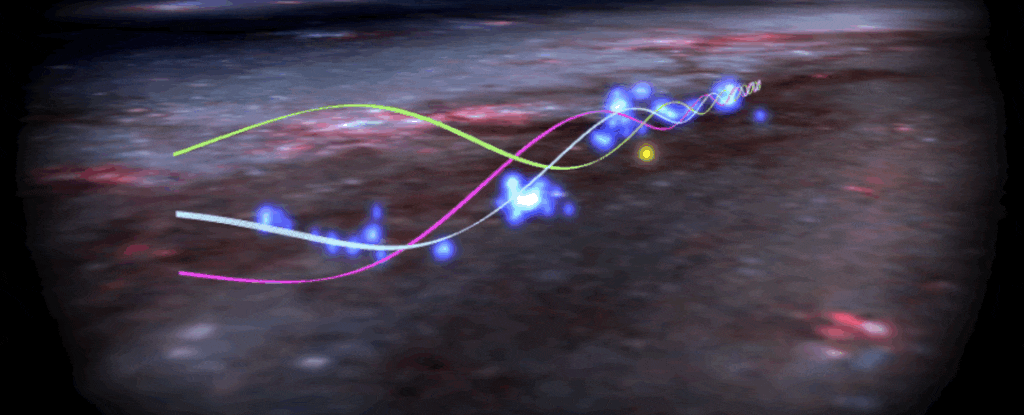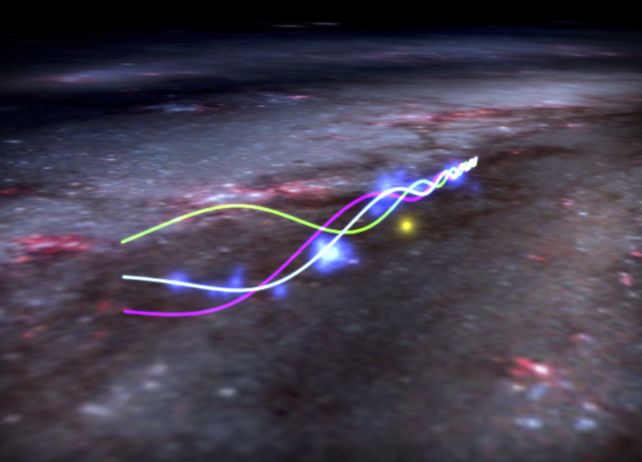Key takeaways:
- The Radcliffe Wave, a massive 9,000 light-year long star-forming structure in the Milky Way, is not just orbiting the galaxy but also oscillating like a traveling wave.
- Scientists used Gaia spacecraft data to map the 3D positions and motions of baby stars along the Radcliffe Wave, revealing its undulating motion through the Milky Way.
- The wave-like movement of the Radcliffe Wave can be explained by the gravitational influence of normal matter in the galaxy, without needing to invoke dark matter.
- The formation of the Radcliffe Wave, and its motion, may be linked to events such as supernovae or gravitational interactions with other galaxies.
- There may be more wave-like structures in the Milky Way waiting to be discovered, which could provide insights into galaxy formation and gravitational dynamics.
____________________________
The Radcliffe Wave, a 9,000 light-year-long structure, is oscillating through the Milky Way.

The Milky Way galaxy is far from static. One striking example of its dynamic nature is the discovery of the Radcliffe Wave, a massive, 9,000 light-year-long structure made of star-forming gas. Located just 500 light-years from the Solar System at its nearest point, the Radcliffe Wave was first identified in 2018 using data from the Gaia spacecraft, with findings published in 2020. But recent research has unveiled something even more intriguing: this enormous structure is not just moving in its orbit around the galactic center, it’s also oscillating like a wave.
Gaia’s Contributions and New Discoveries
Gaia, a spacecraft designed to map the Milky Way in three dimensions, has revolutionized our understanding of our galaxy. By measuring the positions, motions, and velocities of stars, Gaia provides the most precise galactic map ever created. It was through this data that scientists discovered the Radcliffe Wave. However, in the initial discovery, there wasn’t enough information to fully comprehend the structure’s properties.
A recent release of additional Gaia data allowed researchers, led by astrophysicist Ralf Konietzka of Harvard University, to take a closer look. They tracked the motion of newly formed stars within the wave’s gaseous clouds and found that the entire structure oscillates like a periodic traveling wave. This discovery highlights that the Radcliffe Wave is not just a static feature of the Milky Way but an undulating entity, akin to a cosmic serpent winding through space.
What Drives the Wave?
The study, which analyzed the three-dimensional motion of the baby stars, suggests that the gravity produced by ordinary matter in the galaxy is likely responsible for the wave’s oscillation. Fortunately, this means that dark matter, while a significant cosmic force, isn’t required to explain the wave’s behavior—at least for now.
Intriguingly, researchers propose that supernova explosions that occurred within the Radcliffe Wave may have created the bubble of space where the Milky Way resides today. This provides additional clues about the wave’s influence on the galaxy’s overall structure and star formation patterns.

Unanswered Questions and Future Exploration
Despite these discoveries, the mystery of the Radcliffe Wave remains far from solved. Why did this wave form, and what causes its distinctive motion? Is the Radcliffe Wave a unique feature, or are there other similar structures hiding in the Milky Way or beyond? Some theories suggest that gravitational interactions with satellite galaxies or past collisions with other large galaxies could have triggered the wave’s formation and motion.
Astronomer Alyssa Goodman of Harvard University raises many questions for future research: “Does this waving happen throughout the galaxy? In all galaxies? Or only occasionally?” The possibilities are endless, and the answers are still out there, waiting to be discovered.
Upcoming wide-area surveys of stars, gas, and dust are expected to reveal more about wave-like structures in the galaxy. These findings could offer new insights into the history of star formation and the gravitational forces shaping galaxies like the Milky Way.



No comments:
Post a Comment